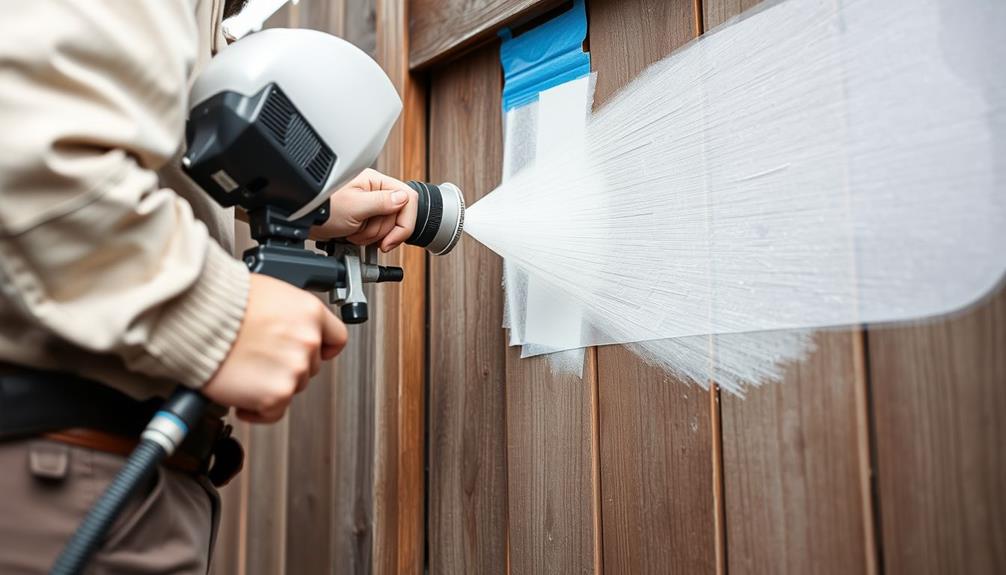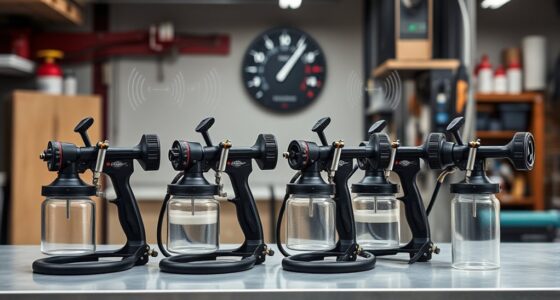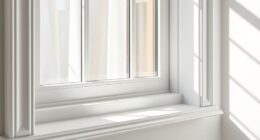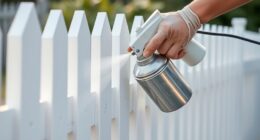To avoid overspray with an airless paint sprayer, maintain a distance of 12 inches from the surface. Use high-efficiency airless (HEA) tips to minimize waste and control spray patterns. Lowering the spray pressure can also help you achieve better results. Always hold the spray gun perpendicular to the surface for even coverage, and practice smooth, consistent strokes. Additionally, consider using physical barriers or spray guides to protect surrounding areas. Mastering these techniques not only reduces cleanup but can improve your overall efficiency. Keep exploring to discover more tips and tricks for achieving a perfect finish every time.
Key Takeaways
- Maintain a distance of about 12 inches from the surface to ensure an even spray pattern and reduce overspray.
- Use high-efficiency airless (HEA) tips operating at around 1000 PSI to minimize paint waste and improve control.
- Hold the spray gun perpendicular to the surface for accurate coverage and optimal spray pattern delivery.
- Start with the lowest effective PSI and adjust pressure settings to find the best balance for reduced overspray.
- Utilize physical barriers and spray guides to capture overspray and enhance control during application.
Importance of Managing Overspray
Managing overspray is vital for any painting project. When you minimize overspray, you not only reduce paint waste but also use your materials more efficiently, which can markedly cut your overall project costs. By implementing effective overspray management techniques, you could see reductions in paint consumption of up to 35% with high-efficiency airless (HEA) tips.
Airless paint sprayer basics provide useful insights into how to achieve an even finish while reducing overspray. Less overspray translates to improved productivity. With less time spent on cleanup and reapplication, you'll enhance your job efficiency and completion rates.
Plus, when you manage overspray effectively, you can confidently spray in challenging environments, such as around vehicles or delicate surfaces, without the worry of damaging adjacent areas.
Moreover, controlling overspray contributes to a safer job site. It minimizes the need for extensive prep work and reduces hazards associated with ladders and scaffolding during painting tasks.
Fundamentally, by focusing on ways to minimize overspray, you not only optimize your painting process but also create a safer, more efficient work environment. Understanding the importance of managing overspray can lead to better results in your painting projects, making it a vital aspect to prioritize.
Techniques for Reducing Overspray

To reduce overspray, you should maintain a proper distance of about 12 inches from the surface you're painting.
Additionally, considering the use of a quality garage door opener can enhance your workspace's safety by keeping areas clear of unnecessary obstacles.
Lowering your spray pressure, especially using High-Efficiency Airless tips, can also make a big difference in minimizing waste.
Maintain Proper Distance
Maintaining a proper distance while using an airless paint sprayer is essential for achieving a smooth finish and reducing overspray. Aim to keep your spray gun about 12 inches from the surface you're painting. This distance helps create an even spray pattern, which minimizes the risk of overspray.
Utilizing tools like the Graco FFLP Fine Finish Low Pressure Reversible Tip can further improve your control and reduce overspray due to its low-pressure design.
It's also important to hold the spray gun perpendicular to the surface. This position guarantees accurate paint coverage and further reduces the chances of overspray onto adjacent areas.
When you aim for a spray pattern that's free of tails and holidays, you notably decrease overspray while enhancing the overall finish quality.
Practice smooth and even strokes while maintaining a consistent distance for better control during the application process. If you find yourself struggling with overspray, check your distance and angle.
Remember, the key is consistency—both in distance and technique. By focusing on maintaining a proper distance, you'll not only reduce overspray but also achieve a professional-looking finish.
Adjust Spray Pressure
After ensuring you've got the right distance from the surface, adjusting the spray pressure is the next key step in reducing overspray. Start at the lowest effective PSI to minimize paint waste while achieving proper atomization. High-pressure settings can create excessive overspray, so gradually increase the pressure until you find the ideal setting for your specific project.
Using high-efficiency airless (HEA) tips can also help. These allow for operation at around 1000 PSI, resulting in up to 55% less overspray compared to traditional tips. Maintaining a consistent distance of about 12 inches from the surface helps control the spray pattern, further minimizing overspray.
Experimenting with different tip sizes and fan patterns while adjusting pressure settings can lead to significant improvements. Check out the table below for a quick reference on pressure adjustments:
| PSI Level | Overspray Risk | Recommended Tip Size |
|---|---|---|
| 1000 | Low | HEA Tip |
| 1500 | Moderate | Standard Tip |
| 2000 | High | Large Tip |
Technological Advances in Spraying
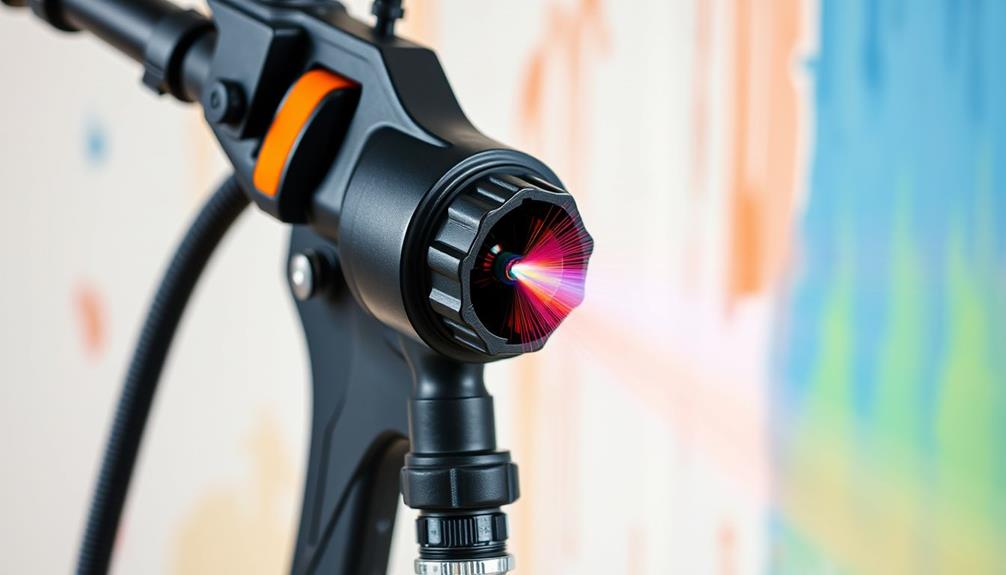
Recent advancements in airless paint sprayer technology have revolutionized how you approach painting projects, especially with the introduction of low-pressure spraying techniques. These innovations considerably reduce overspray while ensuring effective paint application.
High-efficiency airless (HEA) tips are a game changer, operating at just 1000 PSI, and they can produce up to 55% less overspray compared to traditional tips. Additionally, using air purifiers can improve the overall air quality in your workspace, which is beneficial during painting projects where fumes may be present air purifiers reduce allergens.
By utilizing HEA tips, you can also achieve estimated savings of 35% in paint consumption, making your projects not only efficient but also cost-effective. These advances deliver better control over spray patterns, creating softer fan patterns that enhance finish quality.
With airless sprayers that incorporate HEA technology, you'll find it easier to apply paint smoothly and evenly, resulting in a professional-looking finish.
Moreover, these tips reduce wear on your equipment, extending its lifespan and ensuring you get the most out of your investment. As you embrace these technological advances in spraying, you'll notice a marked improvement in your painting results, allowing you to tackle projects with greater confidence and efficiency.
Accessories to Control Overspray
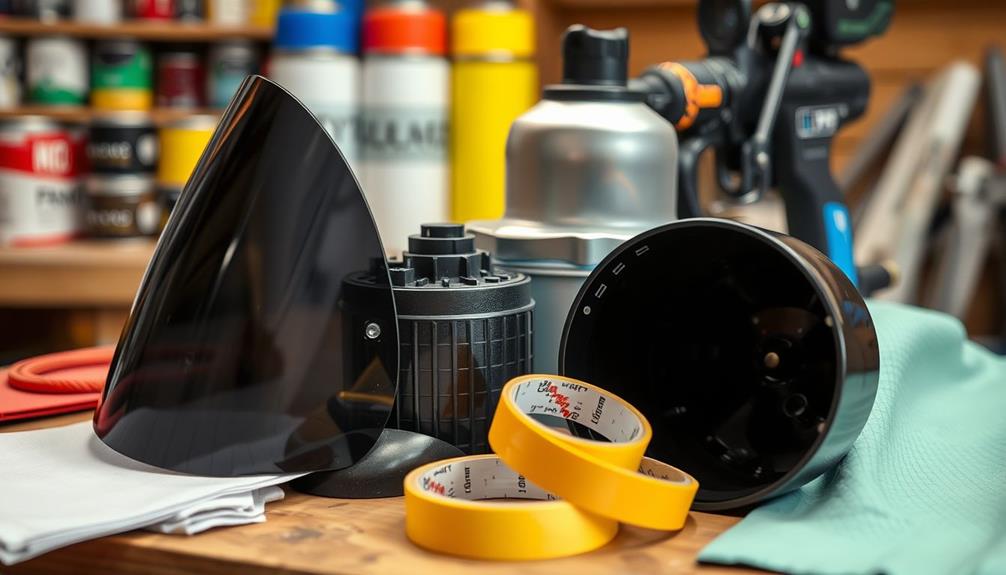
To achieve a clean and professional finish while minimizing overspray, incorporating the right accessories is key. Using physical barriers like cardboard or metal shields can effectively protect adjacent surfaces from overspray during airless spraying applications. Spray guides that attach directly to your spray gun help capture and control spray patterns, guaranteeing precise application.
Additionally, spray rollers offer a great combination of spraying and rolling techniques, allowing for efficient coverage while considerably reducing the likelihood of overspray on surrounding areas. For those hard-to-reach spots, extensions and reach tools provide enhanced control when spraying at heights, which helps maintain proper technique and further minimizes overspray.
Here's a summary of helpful accessories:
| Accessory Type | Purpose | Benefits |
|---|---|---|
| Physical Barriers | Protect adjacent surfaces | Reduces overspray risk |
| Spray Guides | Control spray patterns | Guarantees precise application |
| Spray Rollers | Combine spraying and rolling | Efficient coverage, less overspray |
| Extensions & Tools | Enhance reach and control | Maintains technique, minimizes overspray |
Utilizing these accessories designed for overspray control can dramatically improve your paint application quality and reduce cleanup efforts.
Benefits of Effective Overspray Management
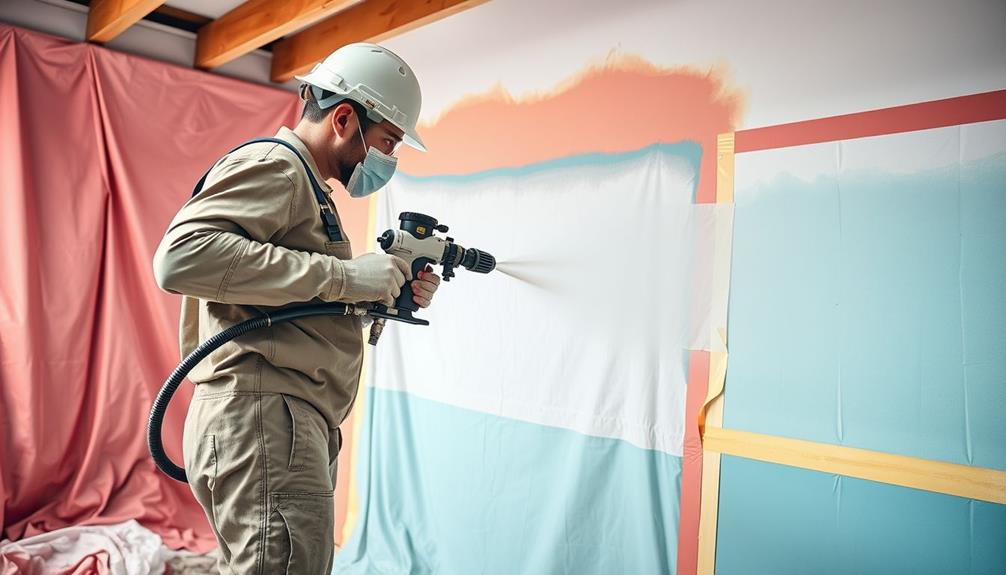
When you manage overspray effectively, you boost job efficiency, allowing you to complete projects faster and with fewer mistakes.
This not only saves time but also reduces the environmental impact by cutting down on wasted materials.
Additionally, understanding the importance of protecting your savings can lead to more strategic investment decisions in your business.
Plus, a cleaner application enhances the overall quality, leading to happier customers and a more profitable business.
Enhanced Job Efficiency
Mastering effective overspray management is key to enhancing job efficiency in airless painting projects. By controlling overspray, you can greatly reduce the time spent on cleanup and reapplication, allowing you to complete projects faster.
Incorporating eco-friendly practices, such as choosing low-emission paints, can further align with sustainable energy solutions, similar to how geothermal energy utilizes the earth's internal heat to generate electricity. When using high-efficiency airless (HEA) tips, you could cut paint consumption by up to 35%, leading to substantial cost savings.
Implementing techniques to minimize overspray not only improves the quality of your paint application but also results in fewer defects and touch-ups. This translates into saved labor time and a more polished finish.
Additionally, effective overspray management contributes to a safer job site by reducing the need for ladders and scaffolding, which lowers the risk of accidents and injuries.
As you enhance efficiency through careful overspray control, you'll notice a positive impact on your profitability. With reduced material waste and increased productivity, your project margins will improve, allowing you to take on more work without sacrificing quality.
In short, mastering overspray management isn't just about aesthetics—it's essential for maximizing your overall job efficiency and boosting your bottom line.
Environmental Impact Reduction
Effective overspray management plays an essential role in reducing environmental impact during painting projects. When you effectively control overspray, you can cut paint waste by up to 55%, which not only lowers your material costs but also minimizes your ecological footprint. Using high-efficiency airless (HEA) tips can lead to an additional 35% savings in paint consumption.
Here's a quick overview of the benefits of effective overspray management:
| Benefit | Description | Impact |
|---|---|---|
| Reduced Waste | Cuts down on excess paint and materials used | Lowers costs and impact |
| Enhanced Efficiency | Speeds up project completion and cleanup | Saves time and resources |
| Improved Safety | Minimizes hazardous waste and cleanup | Creates a safer job site |
Related Products and Resources
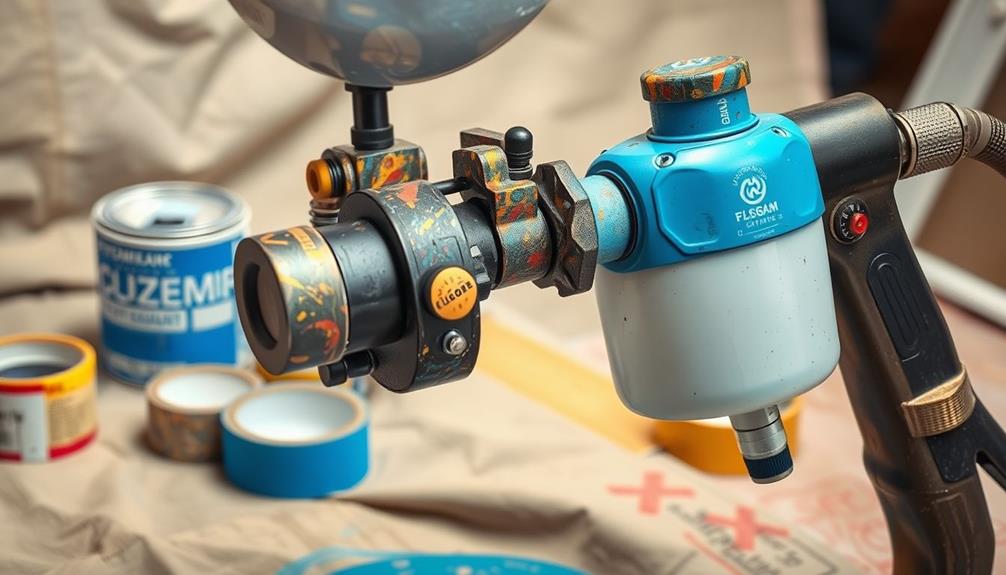
Choosing the right equipment can greatly enhance your airless painting experience. For best results, consider the Graco Magnum Pro X17, which offers a high-pressure capability of 3000 PSI and a flow rate of 0.34 GPM. This model allows for reduced overspray when paired with the correct techniques and tip selection, making it essential for projects that require precision and control.
Additionally, exploring island getaways can provide inspiration for color choices and themes that can translate beautifully into your painting projects.
Alternatively, the Airlessco SL1250 boasts a maximum pressure of 3300 PSI and a flow rate of 0.95 GPM, making it ideal for professional applications while minimizing paint waste.
If you're looking for efficiency, the Airlessco MP455, also at 3300 PSI but with a flow rate of 0.48 GPM, is designed to enhance paint application while controlling overspray.
Don't forget to invest in high-efficiency airless (HEA) tips; they can lead to up to 55% less overspray and save you up to 35% in paint consumption.
Additionally, utilizing supplemental spray equipment like HVLP spray guns or spray rollers can enhance your control and further reduce overspray during your projects.
Frequently Asked Questions
How to Avoid Overspray With an Airless Sprayer?
To avoid overspray, keep your sprayer at a consistent distance from the surface, use the right tip size, and maintain a steady hand. Adjust pressure settings, and practice proper techniques for better control.
What Is the Number One Rule When Using Airless Spray Guns?
The number one rule when using airless spray guns is to use the lowest pressure needed for proper atomization. This not only minimizes overspray but also conserves paint, ensuring you get the best results possible.
How Do You Get a Smooth Finish With an Airless Sprayer?
To get a smooth finish, you'll want to start with low pressure and choose the right tip size. Keep a steady distance, use even strokes, and consider warming your paint for better flow.
What Type of Paint Sprayer Has the Least Overspray?
If you're looking for the least overspray, consider HVLP spray guns. They operate at lower pressures, providing excellent control and precision, which minimizes waste and helps achieve a smooth finish on your projects.
Conclusion
By mastering airless paint sprayer techniques, you're not just avoiding overspray; you're crafting a masterpiece with every stroke. Think of your project as a canvas, where precision is the brush and control is the palette. With the right methods and tools, you can dance around those pesky overspray issues, leaving nothing but vibrant colors and smooth finishes in your wake. Embrace these strategies, and watch your painting transform into a flawless work of art!
